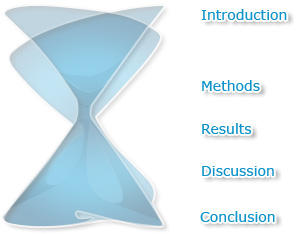Manuscript structure: How to convey your most important ideas through your paper

The core purpose of writing a paper is to go beyond mere presentation of facts and thoughts. It is to reach out to the reader—to communicate your research effectively and help readers understand the issues at hand.
This article introduces and illustrates various concepts for structuring a manuscript such that readers take away the most important messages—the messages you want to convey—after reading your paper.
The philosophy behind a good manuscript structure
A crucial point to remember while writing a research paper is that readers do not simply read; they interpret.1 Different readers are likely to extract different meanings from your paper, depending on their expectations or the clues they receive from the manuscript’s structure. This brings us to a concept that serves as the foundation of good writing practices1:
Manuscript structure: The essential elements
A fitting analogy to the structure of most research manuscripts would be an hourglass.2 The manuscript begins with broad statements, narrows down to the specifics of your study, and ends with broad considerations. This section presents the basic components of a manuscript and outlines the essential functions and content of each part.2-6

Introduction (What are you studying and why?)
Use this section to set the context for your study and problem. Remember that several readers may not understand the significance of your study right away. Therefore, use general language and carefully developed logic to guide your readers to the main problem/objective of your study.
DOs and DON’Ts
- Describe the rationale for undertaking the study
- Explain how the research makes an important contribution to the field or advances knowledge
- State the research question clearly
- Explain the theoretical framework that the study is based on
- Provide a background of the problem or issue that your research aims to understand or resolve, citing studies to support your arguments
- Summarize the current state of knowledge on the topic, citing studies as appropriate
- Don't review all studies that have ever been published on the topic
Methods (What did you do?)
This section is the most specific to your study. A primary criterion for well-conducted research is that it must be replicable. This means that another researcher should be able to reproduce the results by following the methods detailed in your paper.
DOs and DON’Ts
- Provide full details of all methods, techniques, and instruments
- Include photograph or diagram of the experimental setup
- Describe the questionnaire, survey, or other data collection instruments
- Provide or cite studies that support the validity and reliability of the analysis methods and instruments
- Describe the lab settings or environment
- Explain the analysis methods and why you chose them
- Don’t exclude important details simply to avoid a lengthy description of the methods
Results (What did you find?)
Include all the details of your data and results in this section. Highlight the most significant findings in the text and then move on to the peripheral findings. Readers should be able to understand your results without spending too much time reading this section.
DOs and DON’Ts
- Use tables and figures effectively to present results in a manner that’s easy to understand at a glance
- Describe the actual data rather than provide generalizations
- State the main findings in the text
- Highlight any unexpected or surprising results in the text
- Explain what the results are saying, rather them simply stating the statistical data (e.g., “X was found to substantially increase with Y [followed by statistical data]” rather than “X and Y had a positive correlation of .73”)
- If you have illustrated the results of your study in figures and tables, do not include detailed descriptions of these results in the text
Discussion (What do your findings mean?)
A good discussion section extends the specific results to their broader implications, which can then be tied in with the general background given in the introduction to maximize the impact of the overall paper. Therefore, remember to go “back and forth” between your discussion section and the introduction.
DOs and DON’Ts
- Start by stating whether your hypothesis was supported
- Interpret the results: what do the results imply?
- Relate your findings to those of previous studies, for example, whether your results support or deviate from results in previous studies
- Explain how the study adds to previous knowledge
- Remember to mention any possible alternative explanations for the results
- Address the limitations of the study
- Don’t simply repeat the results again
- Don’t draw conclusions that are not supported by the data
Conclusion (What have you learned from the study?)
In this section, state the main conclusions of the study in the context of the formulated problem. By the time readers reach this part of the text, they should have understood what you did and the outcomes of the research. Readers should be able to understand how and why you reached your conclusions.
DOs and DON’Ts
- Explain what you’ve learned from the study
- Ensure that the conclusion is directly related to your research question and stated purpose of the study
- Elaborate on the broader implications of the research
- Suggest specific future avenues of research to advance the knowledge you’ve gained from the study or answer questions that your study did not address
- Don’t oversell your research or “overgeneralize” the results, that is, stretch the study findings to provide suggestions or conclusions that the research doesn’t really support
- Don’t simply summarize the results
Writing for different groups of readers
- A good writer is aware of what different types of readers may be expecting from the paper and can structure a paper according to the readers’ expectations and backgrounds. Even a general reader with little or no knowledge of the field should be able to get a broad understanding of what you did and why.2
- Avoid jargon. Clearly define key terms, especially ones that are not used in their conventional sense or ones that few readers can be expected to be familiar with.
- If only specialists in your field can understand what you’re saying, your paper will not be read by a wide audience. Lead readers up to the problem or theory you are studying. Don’t assume that readers know everything about the topic of your research.

To be an effective author, keep the reader in mind while writing your paper. A well-structured manuscript helps you enhance the flow of your ideas and tells readers what to expect at different parts of the manuscript.
For further reading, refer to these posts:
Published on: Nov 04, 2013
Comments
You're looking to give wings to your academic career and publication journey. We like that!
Why don't we give you complete access! Create a free account and get unlimited access to all resources & a vibrant researcher community.

Subscribe to Conducting Research













